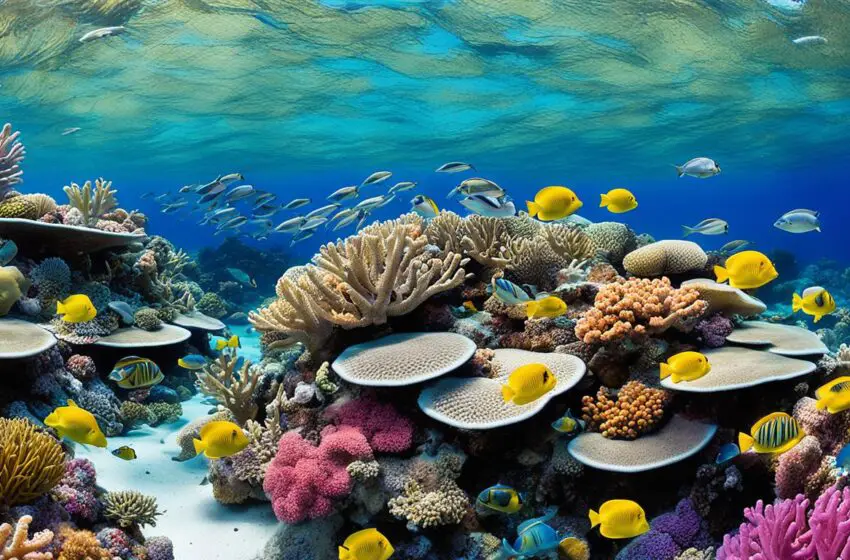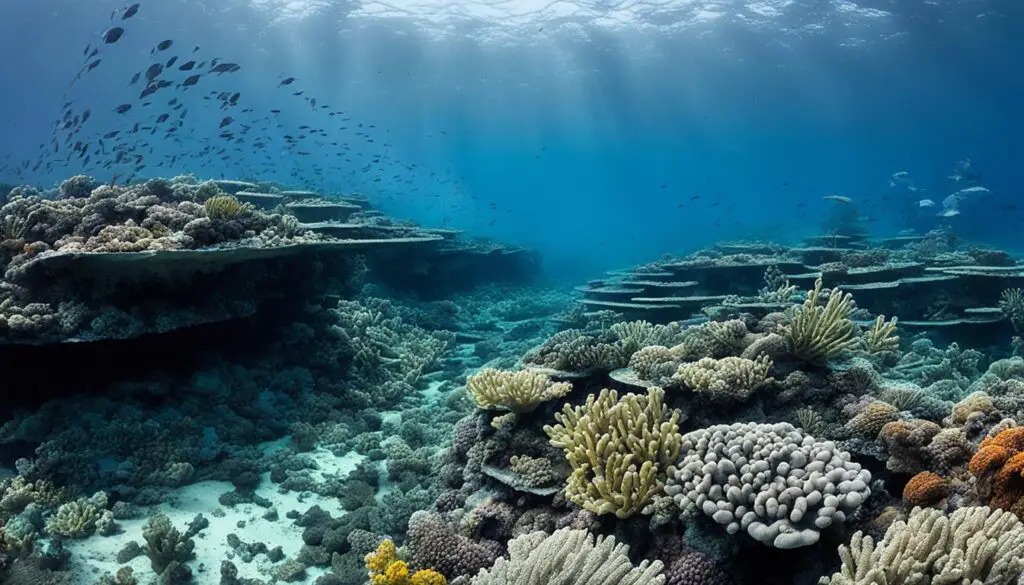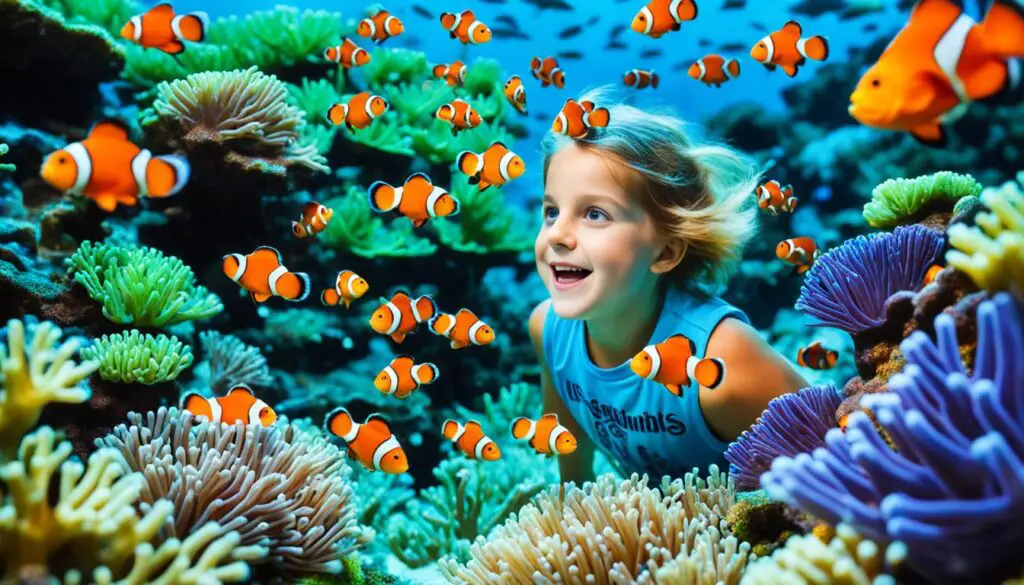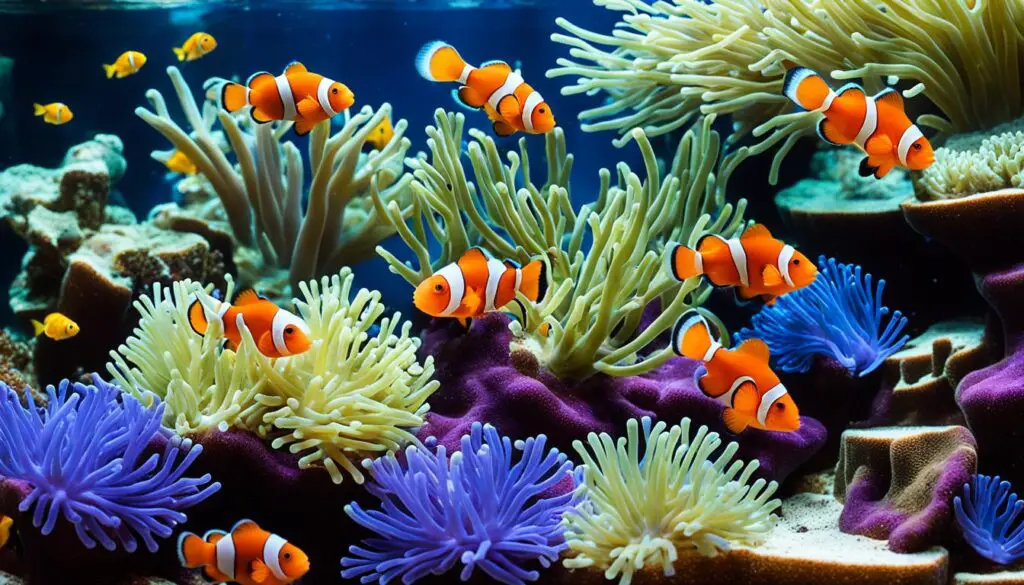Coral Reef Protection: Preserving Paradise: Essential Coral Reef Protection Measures!

Welcome to our article on coral reef protection! Coral reefs are a key part of our ecosystem. They are known as the “rainforests of the sea.” These underwater worlds are full of life and help people living near them.
But, these beautiful places are under threat. Overfishing, building near the coast, pollution, climate change, and diseases are hurting them. A study found that by 2030, over 90% of reefs might be in danger.
We must take action to protect coral reefs. This includes making fishing rules stricter and promoting fishing that doesn’t harm the reefs. Education can help stop overfishing and illegal fishing too. We also need to plan how and where we build near the coasts to keep the reefs safe. Plus, we must work on lowering pollution.
Key Takeaways:
- Overfishing, coastal development, pollution, climate change, and coral diseases are major threats to coral reefs.
- Stricter regulations and sustainable fishing practices are essential for reef conservation.
- Educating communities about the importance of reefs and sustainable fishing is crucial.
- Coastal development should be carefully planned to avoid damaging coral reefs.
- Pollution reduction is necessary to protect coral reef ecosystems.
The Impact of Climate Change on Coral Reefs and Hawaii’s Experience
Climate change is greatly affecting coral reefs across the world. The outcome is very hard on these systems. A key issue is more and more corals are losing their color, known as bleaching. This happens when the water gets too warm and the coral loses the algae that give them food and color.
Places like Hawaii, famous for their vibrant reefs, are seeing this problem. It’s causing the health of the coral to drop. Less healthy coral leads to trouble for all the creatures that depend on them.
The coral in Hawaii faces more than just climate change. Things like pollution, too much soil washing off the land, and overfishing are making it even harder for the reefs to stay healthy. Because of all these issues, there are fewer fish and the reefs are in bad shape.
To save Hawaii’s reefs, everyone needs to help out. We can start by keeping our water clean and changing how we fish to more sustainable methods. Laws and programs that reduce pollution and damage from tourism can also make a big difference. Projects that grow new coral, like the Kuleana Coral Reefs, are important too. They help heal the reefs and show why it’s so important to protect them.

| Impact of Climate Change on Hawaiian Reefs | Sustainability Measures |
|---|---|
| Increasing severity of bleaching events | Better water management |
| Worsening reef health | Bans on fishing that harms reefs |
| Less fish in the ocean | Laws to fight pollution |
| Other issues: dirty water, too much soil, overfishing, and too many tourists | Efforts to grow new coral |
The Importance of Coral Reefs: Biodiversity, Coastal Protection, Tourism, and Medicines
Being an avid scuba diver, I’ve seen the amazing life in coral reefs up close. These areas are packed with different species, making up a big chunk of the total ocean fish. They are lively and interconnected, creating a rich environment. For about a billion people, reefs are vital for jobs and food.
Coral reefs do more than just support life. They act like natural walls that protect shores from floods and erosion. Their role in reducing wave power saves coastal areas from severe damage. This is especially important with sea level rise and stronger storms.
Reefs boost the economies of nearby places too. Their beauty and marine life draw visitors, benefiting local businesses and creating jobs. This income helps communities stay strong and helps in the conservation of these areas.
Surprisingly, these reefs have also helped in medicine. Enzymes and compounds from corals could fight diseases and cancer. Such discoveries show that protecting reefs matters not only for nature but for health breakthroughs as well.
FAQ
What are the main threats to coral reefs?
The main threats to coral reefs include overfishing and coastal development. Pollution is another big issue, along with climate change and coral diseases.
How many coral reefs will be threatened by 2030 if no action is taken?
A study found that more than 90% of the world’s reefs could be in danger by 2030. This is if we don’t act to protect them.
What are the benefits of coral reefs?
Coral reefs benefit us in many ways. They purify water, protect shorelines, and help make food and money. They also draw tourists and offer new medicines.
What measures can be taken to protect coral reefs?
Protecting coral reefs requires stricter rules and sustainable fishing. Education, planning for coastal development, cutting pollution, and community help are also crucial.
How does climate change impact coral reefs?
Climate change causes bleaching, acidifying the ocean, and weakens coral. These impacts hurt coral reefs badly.
What are the challenges faced by Hawaiian reefs?
Hawaiian reefs have issues like wastewater pollution and overfishing. Runoff and tourism also harm them, as does climate change.
How can Hawaiian reefs be conserved?
To save Hawaiian reefs, we need better water control and bans on harmful fishing. Laws to stop pollution and efforts to grow coral back can also help.
Why are coral reefs important?
Coral reefs are key for keeping the sea diverse, protecting the coast, and bringing in money. They also offer potentially lifesaving medicines.
How many people depend on coral reefs for their income and food?
About one billion people rely on coral reefs to support their lives. They use them for food and to earn money.
How do coral reefs contribute to coastal protection?
Coral reefs are crucial for guarding against floods and erosion. They help lessen storm damage along coastlines.



